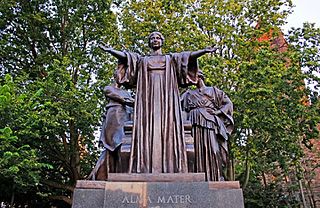
Marycrest College Historic District is located on a bluff overlooking the West End of Davenport, Iowa, United States. The district encompasses the campus of Marycrest College, which was a small, private collegiate institution. The school became Teikyo Marycrest University and finally Marycrest International University after affiliating with a Japanese educational consortium during the 1990s. The school closed in 2002 because of financial shortcomings. The campus has been listed on the Davenport Register of Historic Properties and on the National Register of Historic Places since 2004. At the time of its nomination, the historic district consisted of 13 resources, including six contributing buildings and five non-contributing buildings. Two of the buildings were already individually listed on the National Register.

Upper Dublin School District is located in Upper Dublin Township, Montgomery County, in the Commonwealth of Pennsylvania.

Enfield High School is a secondary school established in 1893 in Enfield, Connecticut. The Enfield High School campus is located in the Connecticut River Valley, on Enfield Street in Enfield's Historical District. The school has an enrollment of approximately 1400 students. The present facility was erected in 1964 on Enfield Street. The facility underwent a $6.2 million renovation and library addition completed in 2005, and a $103 million "as-new" renovation and significant expansion completed in 2017. In May 2010, Enfield High School and Enrico Fermi High School underwent a consolidation process as part of the restructuring and improvement plan of Enfield Public Schools. Enfield High School operates as the town's sole high school, which houses both students from Enfield High School and the previous Enrico Fermi High School, which closed its doors in 2016.

The University of Illinois Urbana-Champaign is an academic research institution that is the flagship campus of the University of Illinois System. Since its founding in 1867, it has resided and expanded between the twin cities of Champaign and Urbana in the State of Illinois. Some portions are in Urbana Township.

South Whidbey School District #206 is a school district that operates on the "Southend" of Whidbey Island in the US state of Washington. The district offices are located in Langley. The current superintendent is Dr. Jo Moccia. The current school board consists of Brook Willeford, Andrea Downs, Marnie Jackson, Ann Johnson, Joe Greenheron, and two Student Representatives, Audrey Gmerek and Katya Schiavone.

Newberg High School (NHS) is the only public high school in Newberg, Oregon, United States. It is a part of Newberg-Dundee Public Schools.

YMCA Boston was founded in 1851 in Boston, Massachusetts, as the first American chapter of YMCA.

The Jefferson Intermediate School is a school building located at 938 Selden Street in Detroit, Michigan. It is also known as Jefferson Junior High School or Jefferson School. The school was listed on the National Register of Historic Places in 1997.

Webster Groves High School is a public secondary school in Webster Groves, Missouri, United States. It is located at 100 Selma Ave, Webster Groves, MO. The school is part of the Webster Groves School District and its current principal is Matt Irvin.

Old Crawfordsville High School is a former public high school erected in 1910 on East Jefferson Street in Crawfordsville, Montgomery County, Indiana. It was a part of the Crawfordsville Community Schools. The old building was expanded in 1914, 1921, and 1941 to provide additional classrooms, an auditorium, and a gymnasium. A new Crawfordsville High School facility opened at One Athenian Drive in 1993. In 2000 the old school building was converted to a multi-use facility of offices, residential housing, and a fitness center. The former high school building was added to the National Register of Historic Places in 2003. The former high school became a senior living facility and in 2019 was converted into 99 apartment units called The Laurel Flats.

St. Katherine's Historic District is located on the east side Davenport, Iowa, United States and is listed on the National Register of Historic Places. It is the location of two mansions built by two lumber barons until it became the campus of an Episcopal girls' school named St. Katharine's Hall and later as St. Katharine's School. The name was altered to St. Katharine-St. Mark's School when it became coeducational. It is currently the location of a senior living facility called St. Katherine's Living Center.

Buffalo High School, also known as Independent School District #1 and Buffalo Elementary School, is an historic building located in Buffalo, Iowa, United States. It was listed on the National Register of Historic Places in 2005.

McKinley Elementary School is located on the east side of Davenport, Iowa, United States. It was listed on the National Register of Historic Places in 2002.

Madison Elementary School is located in Davenport, Iowa, United States. It was nominated for, but not listed on, the National Register of Historic Places on September 9, 2002, with reference number 02001226.

The Davenport Community School District is a public school district in Scott County, Iowa. The school district covers 109 square miles (280 km2) that includes the city of Davenport, where it is based, and the western Scott County communities of Blue Grass, Buffalo and Walcott in addition to a small section of Muscatine County. Founded in 1858, it established one of the first publicly-funded high schools in the United States, the third teachers’ training school, and hired the first female superintendent in the country. It serves nearly 16,000 students in 32 school buildings.

The Hopewell High School Complex, also known as James E. Mallonee Middle School, is a historic former school campus located at 1201 City Point Road in Hopewell, Virginia, United States. Contributing properties in the complex include the original school building, athletic field, club house, concession stand, press box, Home Economics Cottage, gymnasium and Science and Library Building. There are two non-contributing structures on the property.

McKinley Elementary School is a former school building located at 640 Plum Street in Wyandotte, Michigan. It was listed on the National Register of Historic Places in 2017.
Clarion–Goldfield Community School District was a school district headquartered in Clarion, Iowa. It covered 254 square miles (660 km2) of area, mostly in Wright County with some portions in the counties in Hancock and Humboldt. In its service area were Clarion, Galt, and Goldfield, as well as the unincorporated communities of Cornelia and Holmes.

The Cherokee Community School District is a rural public school district based in Cherokee, Iowa. The district is completely within Cherokee County, and serves the towns of Cherokee and Larrabee and surrounding areas.

Bingham School is a former elementary school located at 555 South 5th Avenue in Alpena, Michigan. It was listed on the National Register of Historic Places in 2020.






















